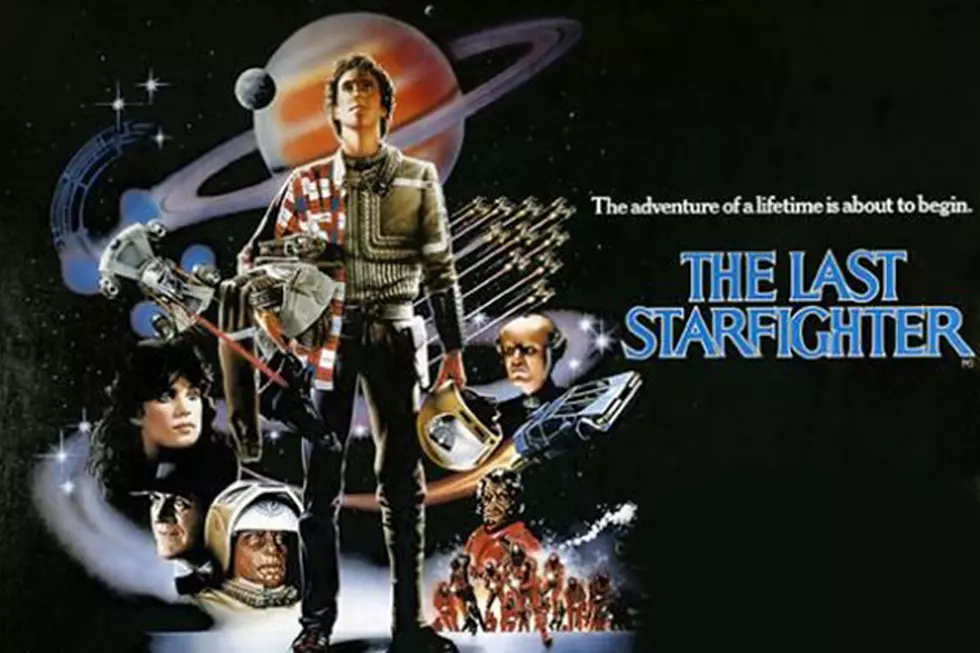
35 Years Ago: ‘The Last Starfigher’ Empowers Teens to Save the Galaxy
Once upon a time, no one was making movies about the idea that being a teen, and doing the things that teens do, would save the world. Then came the '80s.
It was the decade of Steven Spielberg and John Hughes. Of Footloose and Revenge of the Nerds and The Goonies. It was the decade when youth culture, which had blossomed rebelliously in the '60s and grown deliquescent in the '70s, came ravenously back to life and began to pull all of American culture into its web.
It was the decade of The Last Starfighter.
Released in July of 1984, there is maybe no movie that better represents the wonder, awfulness and absurdity of that fabled time.
The story is purely and unabashedly modeled on Star Wars. Alex Rogan (played by Lance Guest, obviously in his 20s) lives in a hard-luck but neighborly trailer park. His dreams outstrip his opportunities and it seems he's doomed to live a boring old life. He has a beautiful girlfriend Maggie (Catherine Mary Stewart) but not even she can quite understand why he's not content with his station.
This all changes when Alex discovers there's something special about him. Like King Arthur lifting the sword from the stone or Luke Skywalker discovering he has the Force in his blood, Alex finds that he has a gift. In his case, it's the fact that he's extremely good at a video game that involves shooting down spaceships. Except it's not a video game at all; it's a secret training device devised by an alien to recruit pilots for a battle against an intergalactic evil empire bent on conquering the universe.
The next thing Alex knows, he's been whisked off into space to join the fight, leaving behind a robot that looks just like him (also played by Guest) so that his friends and neighbors won't be alarmed by his disappearance. In space, Alex vacillates at first – how can he possibly be a hero? – while on earth Beta Alex rather ineptly tries to make out with Maggie and help out around the trailer park. For a moment it seems everything will go to pickles.
But in the end the right order of things is established. Alex accepts his destiny and, along with his plucky alien co-pilot Grig (Dan O'Herlihy), he uses the skills he developed playing the video game to shoot down the alien fighters and destroy the alien mothership. After a triumphant military-style awards ceremony, he returns to Earth just long enough to say hello to the adoring residents of the trailer park and pick up his girlfriend. Then he returns to space to lead the continuing fight against the evil empire.
Is it cheesy and derivative? Absolutely. But one of the things that makes it so much fun – it has become a midnight movie staple, and every decade brings swirling rumors of a sequel – is its lack of pretension. Rather than deny them, it wallows in its silliness, imitation and sentimentality. It is what it is, and it knows what it is, for better or worse.
The recycling of ideas, visuals and even the score from Star Wars is done cheerfully and in the open. The humor is broad and homespun. The teenagers never do anything more than necking, and the main bad guy, Lord Kril (Dan Mason) threatens people with a sort of imperial cudgel on which one could probably see the molding seams on the plastic if one cared to look. Through it all, there is no trace of the undercutting irony so familiar to us now, no winks to the cool kids laughing in the back seats of the theater (which is, ironically, exactly one of the things that makes it popular now at the midnight revivals.)
And beneath this, offering more layers of enjoyment, is the fascinating way The Last Starfighter is embedded in Hollywood history. In part, this is because of the way it connects the slew of Star Wars knockoffs to the cycle of the teen movie cycle of the '80s. And in part this is simply because of fun Hollywood trivia: Nick Castle, who directed the movie, was a film school classmate of John Carpenter and played Michael Myers (or "The Shape" as Myers is known to fans) in the original Halloween. Coincidentally, Lance Guest (Alex) got his big-screen start in Halloween II and Dan O'Herlihy (Grig) appeared in Halloween III: Season of the Witch.
But Starfighter's more important piece of film history comes from the fact that it was one of the first movies to use CGI effects in a large-scale way. The exterior shots of planets, spaceships and battle scenes were all created using a Cray X-MP Supercomputer, which was at the time the fastest computer in the world. The decision to use this technology was made not out of artistic conviction but in an attempt to save money, and the resulting scenes look far worse than do most comparable scenes created with models even 20 years earlier. But without movies like Starfighter trying to innovate, there would be no Matrix or Avatar or Avengers.
Finally, the movie is groundbreaking in its conceit. It shares imaginative territory with things like Orson Scott Card's novel Ender's Game (1984), in which a kid prodigy is recruited and trained in military games in order to prepare him to save humanity, Joel Rosenberg's novel The Sleeping Dragon (1983) in which a group of fantasy role-players get sucked into the world of their game and become their characters, and the Dungeons and Dragons cartoon series (1983-85), which told much the same tale as Rosenberg's novel.
In these stories being nerdy, and being good at nerdy games, is no longer the fatal disease that it had been for time immemorial. Instead, it is the portal to a much larger, more powerful life than any non-nerd could imagine.
This kind of empowerment story – as in Ready Player One or Stranger Things – is now so familiar as to be unremarkable. But there was a time when it did not exist.
And then came the '80s and The Last Starfighter.

